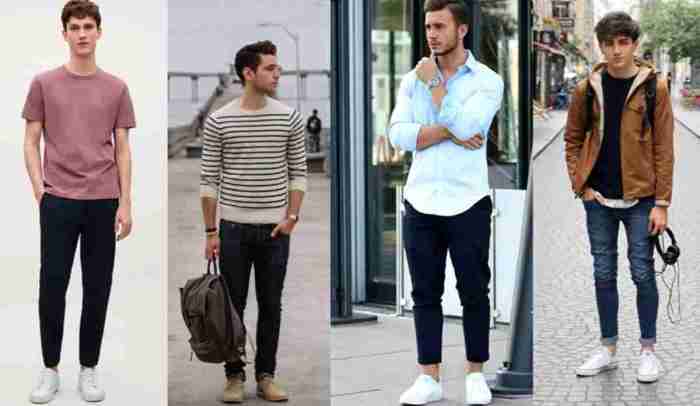Fast Fashion Men Trends, Impacts, and Future
Defining Fast Fashion for Men
Fast fashion men – Fast fashion in the men’s clothing market is characterized by rapid production and turnover of trendy, affordable garments. This approach prioritizes speed and low cost over durability, ethical sourcing, and environmental sustainability.
The rapid turnover of trends in fast fashion men’s clothing often leads to unsustainable practices. However, a contrasting approach can be found by exploring more sustainable and stylish options, such as examining the current landscape of men’s fashion Sweden , known for its minimalist aesthetic and focus on quality. This provides a valuable perspective for those seeking alternatives to the fleeting nature of fast fashion men’s wear.
Characteristics of Fast Fashion Menswear
Fast fashion menswear typically features designs inspired by current runway trends, celebrity styles, and social media influencers. These styles are quickly replicated and made available to consumers at significantly lower price points than traditional or designer menswear. Production relies heavily on low-cost labor and often less sustainable materials.
Price Points and Production Methods

Source: harapanrakyat.com
Price points for fast fashion menswear are generally very low, making it accessible to a wide range of consumers. Production methods often involve mass manufacturing in factories with potentially questionable labor practices, utilizing inexpensive fabrics and prioritizing speed over quality. This contrasts sharply with slower fashion, which emphasizes higher quality materials, ethical production, and longer-lasting garments.
Comparison with Slower Fashion and Sustainable Alternatives
Fast fashion menswear differs significantly from slower fashion and sustainable alternatives. Slower fashion prioritizes quality, durability, and ethical production, often using sustainable materials and paying fair wages to workers. Sustainable alternatives focus on minimizing environmental impact throughout the entire garment lifecycle, from material sourcing to end-of-life disposal. Fast fashion, conversely, often sacrifices these factors for speed and affordability.
Comparison of Fast Fashion Menswear Brands
| Brand | Price Point | Quality | Ethical Considerations |
|---|---|---|---|
| Brand A | Budget-friendly | Low to moderate; prone to wear and tear | Potentially questionable labor practices; limited transparency |
| Brand B | Mid-range | Moderate; decent durability for the price | Some commitment to ethical sourcing; limited information available |
| Brand C | High-end fast fashion | Higher quality materials and construction; better durability | Greater transparency regarding supply chain; some ethical initiatives |
| Brand D | Budget-friendly | Low; short lifespan | Unknown; little information on ethical practices |
Impact of Fast Fashion on Men’s Style Trends
Fast fashion significantly influences men’s style trends, accelerating the adoption of new looks and making them accessible to a broader audience. Social media and celebrity endorsements play a crucial role in shaping these trends and driving consumer demand.
Key Trends Driving Fast Fashion Menswear
Current trends in fast fashion menswear include athleisure-inspired pieces, oversized silhouettes, vintage-inspired styles, and minimalist aesthetics. These trends are frequently updated and reinterpreted, creating a constant cycle of new releases and consumer demand.
Influence of Social Media and Celebrities
Social media platforms like Instagram and TikTok, along with celebrity endorsements, heavily influence the adoption of fast fashion trends. Influencers and celebrities showcase the latest styles, creating a desire for consumers to emulate these looks, often leading to rapid purchases of similar items from fast fashion brands.
Cyclical Nature of Trends
Fast fashion trends are inherently cyclical. Styles reappear, often with slight modifications, creating a sense of novelty while also promoting continuous consumption. This cycle is driven by the constant need to generate new products and maintain consumer interest.
Hypothetical Marketing Campaign
A hypothetical marketing campaign could leverage influencer collaborations and targeted social media advertising to showcase the versatility and affordability of fast fashion menswear. The campaign could focus on showcasing how easily men can incorporate trending styles into their wardrobes without significant financial investment, highlighting the accessibility and ease of updating one’s style with fast fashion.
Environmental and Social Consequences: Fast Fashion Men
The environmental and social consequences of fast fashion menswear production are significant and far-reaching. The industry’s reliance on mass production, low-cost materials, and often exploitative labor practices contributes to environmental pollution, textile waste, and social injustice.
Environmental Impact of Fast Fashion Menswear
The environmental impact includes substantial water pollution from textile dyeing and finishing processes, greenhouse gas emissions from manufacturing and transportation, and massive amounts of textile waste ending up in landfills. The use of synthetic fabrics further contributes to microplastic pollution.
Statistics on Textile Waste
While precise statistics vary, a significant portion of textile waste is generated by the fast fashion industry. Estimates suggest millions of tons of clothing end up in landfills annually, contributing to environmental damage and resource depletion. The lack of robust recycling infrastructure further exacerbates the problem.
Ethical Implications of Fast Fashion Production

Source: gentlemanwithin.com
Ethical concerns revolve around labor practices in many fast fashion factories. Workers often face low wages, unsafe working conditions, and long hours, highlighting the human cost of cheap clothing. Transparency and accountability in supply chains are often lacking.
Potential Solutions to Mitigate Negative Impacts, Fast fashion men
- Promoting sustainable materials and production methods
- Improving waste management and recycling infrastructure
- Enhancing transparency and traceability in supply chains
- Implementing fair labor practices and ensuring worker rights
- Encouraging consumers to buy less and choose more durable, ethically sourced clothing
Consumer Behavior and Purchasing Decisions
Several factors influence men’s purchasing decisions regarding fast fashion clothing, including price, trendiness, and ease of access. Understanding these factors is crucial for analyzing consumer behavior in this market segment.
Factors Influencing Purchasing Decisions
Price sensitivity is a key driver, with many men prioritizing affordability over durability or ethical considerations. The influence of social media and celebrity endorsements also plays a significant role, as does the convenience of online shopping and readily available trends.
Typical Consumer Profile
The typical fast fashion menswear buyer is often younger, price-conscious, and highly influenced by current trends. They may prioritize acquiring the latest styles over investing in high-quality, long-lasting garments. They are often digitally savvy and rely heavily on social media for style inspiration.
Comparison of Shopping Habits
Men who purchase fast fashion tend to shop more frequently and buy more items than those who prefer slower fashion or sustainable alternatives. They may be less concerned with the long-term cost of clothing and more focused on immediate gratification and staying on-trend.
Visual Representation of the Consumer Journey
Imagine a flowchart. It starts with seeing a trendy item on social media (e.g., Instagram). This leads to online browsing on a fast fashion website. Easy navigation and affordable prices encourage a quick purchase. The item is delivered quickly, and the consumer shares a picture on their social media, potentially influencing others to make similar purchases.
The cycle repeats with the next trend.
The Future of Fast Fashion Menswear
The future of fast fashion menswear is likely to be shaped by evolving consumer preferences, technological advancements, and growing pressure to address environmental and social concerns. Brands will need to adapt to remain competitive and sustainable.
Future Trends in Design and Production
Future trends may include increased use of sustainable materials, more efficient production processes, and a greater focus on personalization and customization. Circular economy models, focusing on reuse and recycling, could also gain prominence.
Challenges Facing the Industry
The industry faces significant challenges, including increasing scrutiny of ethical and environmental practices, fluctuating material costs, and changing consumer expectations. Competition from more sustainable brands will also intensify.
Impact of Technological Advancements
Technological advancements, such as 3D printing and AI-driven design, could revolutionize production processes, allowing for greater customization and potentially reducing waste. However, these technologies also need to be implemented responsibly to minimize their environmental footprint.
Strategies for Improving Sustainability and Ethical Practices
Brands can improve by investing in sustainable materials, improving supply chain transparency, implementing fair labor practices, and embracing circular economy models. Collaborations with ethical organizations and initiatives could enhance their credibility and attract environmentally and socially conscious consumers.
Essential FAQs
What are some common signs that a clothing item is fast fashion?
Low price points, poor quality materials that quickly wear out, trendy designs that are quickly outdated, lack of transparency regarding production and sourcing, and an abundance of similar items in multiple stores are all key indicators.
How can men reduce their reliance on fast fashion?
Consider investing in higher-quality, durable garments, opting for secondhand clothing, supporting sustainable and ethical brands, and being more mindful of consumption habits, focusing on quality over quantity.
What are some alternatives to fast fashion menswear?
Slow fashion brands prioritize quality, ethical production, and longevity. Secondhand and vintage clothing offer unique styles and reduce textile waste. Repairing and upcycling existing garments also extend their lifespan and reduce environmental impact.





















